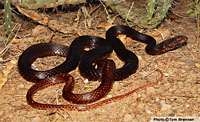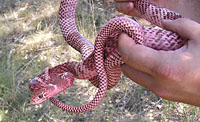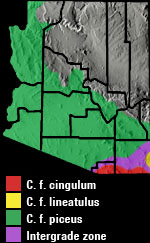Online Field Guide to The Reptiles and Amphibians of Arizona


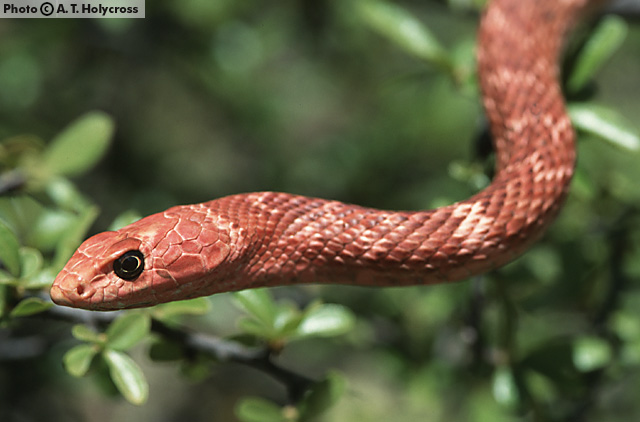
Cochise County, Arizona
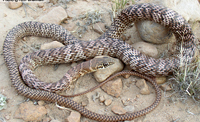 Intergrade. Cochise Co., AZ |
| COACHWHIP Coluber flagellum |
Non-Venomous
|
| DESCRIPTION: A long (up to 1,728 mm or 68″ in total length), thin snake with variable coloration and markings. Across much of its range in Arizona it is a red, pinkish red, orange, rusty brown, or olive-brown snake with dark brown or black bands or suffusions on the neck and anterior portion of the body. Some specimens lack banding. Entirely black specimens are not uncommon in some parts of its range including south-central Arizona. The ventral surface is white or pinkish, often grading to dark pink under the tail. Markings on the scales of the tail often give it the appearance of a braided whip. Young often have more prominent bands than adults. The eyes are large and the pupils are round. The scales are smooth.
DISTRIBUTION: This snake is found across all of western and southern Arizona at elevations ranging from just above sea level along the Colorado River to about 6,000′. HABITAT: It inhabits Arizona’s desertscrub communities, Semidesert Grassland, and the lower reaches of Interior Chaparral. It is found on desert flats, dune fields, sloping bajadas, foothills, and moderate slopes.BEHAVIOR: This fast moving and alert snake forges on the surface during the day. It often hunts with its head elevated high off the ground. It is often active in hot conditions when other snakes seek shelter in cool retreats. Encounters with this snake are usually brief as it wastes little time disappearing into nearby cover when threatened. It spends most of its time on the ground but it is a capable climber that is occasionally encountered in trees and on cacti. It hibernates during the cold months of late fall and winter. When captured it does not hesitate to bite. If persistently harassed it may feign death by tucking the head down close to the ground and remaining motionless.DIET: It is an impressive predator that eats a wide variety of animals including lizards, snakes (including rattlesnakes), mice, birds, insects, bats, frogs, toads, and small turtles.REPRODUCTION: Mating takes place in spring and a clutch of up to 24 eggs is laid in summer. Hatchlings emerge in late summer. SUBSPECIES FOUND IN AZ:SONORAN COACHWHIP Coluber flagellum cingulum. This subspecies is found in southeastern Arizona near the border with Mexico. It has very wide rusty red to dark pink bands separated by narrow, light cream or pale pink, double-bands. The dark bands melt into the lighter pink color toward the tail. The neck is often marked with a light cream collar. LINED COACHWHIP Coluber flagellum lineatulus. This subspecies enters a small portion of southeastern Arizona near the border with New Mexico. It is usually tan or yellow-brown and sometimes has a light brown or tan collar behind the head. Each scale on the anterior portion of the body is marked with a narrow dark horizontal line. Young have dark, thin bands that fade as the animal ages. RED RACER Coluber flagellum piceus. This subspecies is found across western and most of southern Arizona. It is usually pinkish red, rusty red, orange-tan, or olive-brown often with dark brown to black cross bands on the neck and the anterior portion of the body. Some specimens of this subspecies are solid black above. Black specimens are commonly seen in south-central Arizona. REMARKS: Animals that appear to be intergrades occur in subspecies contact zones in Cochise, Pima, and Santa Cruz counties. By Thomas C. Brennan Bartlett. 2000. Snakes of North America: Western Brennan, T. C., and A. T. Holycross. 2006. A Field Guide to Amphibians and Reptiles in Arizona. Arizona Game and Fish Department. Phoenix, AZ Brennan, T. C., and A. T. Holycross. 2005. A Field Guide to Amphibians and Reptiles of Maricopa County. Arizona Game and Fish Department. Phoenix, AZ Degenhardt, W. G., Painter, C. W., and Price, A. H.. 1996. Amphibians and Reptiles of New Mexico. University of New Mexico Press. Albuquerque. Fowlie. 1965. The Snakes of Arizona. Azul Quinta Press, Fallbrook, California Stebbins. 1985. Western Reptiles and Amphibians. Houghton Mifflin. New York, |
|
Visit Partners in Amphibian and Reptile Conservation:


HOME
Copyright © 2023, Arizona Game and Fish Department. All rights reserved.
If you make use of the textual contents of this site in reports, publications, etc. please cite and credit the author(s) and photographer(s). All photos on this website are copyrighted. However, those found in the species account section may be used for any noncommercial scientific, educational, or conservation purposes provided that photographs are not altered and continue to bear the copyright symbol and name of the photographer. Please contact the photographer regarding commercial use of copyrighted photographs.










